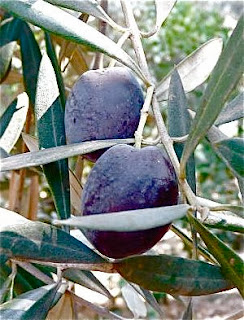
Fresh Olive Crop Is Big,
Despite Labor Shortages
By Patrick Cavanaugh and Laurie Greene
While fresh table olives are still being harvested in Northern California the harvest is finally completed elsewhere in the state. “Most importantly the industry is trying to get the rest of the big crop off as fast as it can, before any rain comes, on top of labor shortages,” said Alex Ott, Executive Director of the California Olive Committee, based in Fresno.
“The labor has been very short. Instead of completing a job in one week, it was taking two weeks,” Ott said. “Labor is our top concern as the fresh olive industry competes with everyone else relying on hand harvests.
Labor has been such a persistent problem for the olive industry, a lot of research is focused on mechanical harvest methods such as a wrap around system similar to prune and pistachio harvesters. “This is definitely the way of the future and all new orchards are being planted and pruned properly so that they can adapt to mechanical system,” said Ott.
 |
| Older Trees Not Adapted to Mechanical Harvest |
“The problem is what do you do with those orchards that have been there for 60 years. And if a grower were to rip those out, why would he go with another hand-labor intensive crop,” asked Ott. “I would plant almonds or walnuts which are not only mechanically harvested, but the rate of return is greater than olives.”
That’s the dilemma of the California olive industry is in. At what point does the industry covert, while also keeping in mind the lower return growers are getting for their black or green ripe olives. “Does it make more sense for growers to go with another crop that doesn’t have such issues,” asked Ott.
Production this year is predicted to be well over 80,000 tons. Last year’s production of 78,740 tons. In 2011 the production was 27,012 tons and in 2010 production was 164,984 tons. “It’s an alternate bearing crop and was a little surprising that we are up this year, following last year’s on crop,” Ott said.
“What is happening here is that growers have initiated improved pruning techniques, which is causing more consistency in crops from year to year. This is good for the olive industry, instead of wild swings each year,” Ott said.
Olive Oil Industry is Up Too
Patricia Darragh, Executive Director of the California Olive Oil Council, reported that estimated California Olive Oil production for the 2013-2014 winter season is 3.0 million gallons, compared to 2.4 last year, double the 1.2 million the prior year, with fantastic quality. Olive is the fastest growing specialty crop in the state.
Versus last year, third-quarter California Extra Virgin Olive Oil represents 20.5% growth of the overall third quarter 41.6% growth nationally. California growth is ascribed to increased consumer demand, excellent health features, ideal climate, and plants attributes of drought-resistance, dry-farmable and indeterminable tree life. California produces 99% of the product nationally, mostly in the Sacramento Valley, with Central Valley a close second.
This year saw a resurgence of the olive fruit fly, attributed to typically non-treated landscape olive trees.
“The most widely used olive in California, among its 100 varieties, is Arbequina, originally from Spain,” said Darragh, “and is a lovely mild, fruity, grassy variety.”
“In contrast with The European olive oil industry, the California industry grows many olive varieties and is creative in its blending, and that is the fun,” Darragh said.
Specializing in marketing and trade, the Council collaborates with the UC Davis Olive Center, which focuses on research and science.
The Council is proud of its Sensory Panel, established in 1998, the first in North America.









